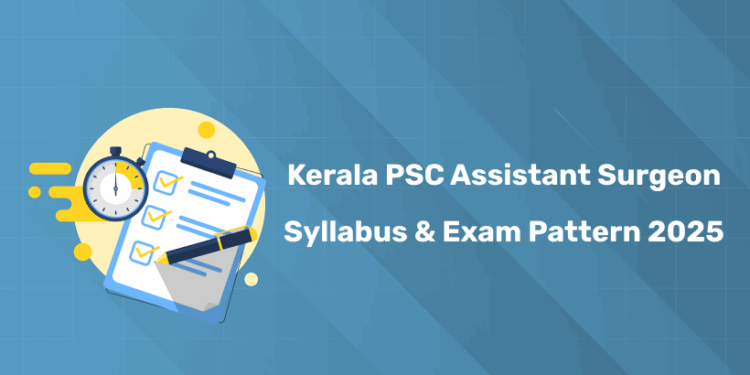Table of Contents
Are you aspiring to become an Assistant Surgeon in Kerala? The Kerala Public Service Commission (PSC) has released the exam pattern and updated syllabus for the post of Assistant Surgeon. In this blog post, we’ll take you through all the essential details about the revised syllabus, exam pattern, and tips on to prepare effectively for this job role. So let’s get started!
Kerala PSC Assistant Surgeon 2025 – Overview
| Particulars | Details |
| Name of recruiting organization | Kerala Public Service Commission (PSC) |
| Name of department | Health Services |
| Name of post | Assistant Surgeon/ Casualty Medical Officer |
| Category No. | 177/2025 |
| Number of vacancies | Anticipated |
| Official website | keralapsc.gov.in |
| Mode of application | Online |
| Mode of recruitment | Direct Recruitment |
Kerala PSC Assistant Surgeon Syllabus 2025 PDF
1: Which Year First Assembly Election was held in Kerala?
The Kerala Public Service Commission (PSC) has officially announced the Assistant Surgeon Exam 2025, which is scheduled to be held on December 1, 2025. Along with the notification, the latest syllabus has also been released to help candidates in their preparation process. You can download the official syllabus PDF below and start your focused preparation at the earliest.
Click on the below link to download Kerala PSC Assistant Surgeon Syllabus 2025 PDF
Enroll in Kerala's Top-rated Kerala PSC Coaching Program!
സർക്കാർ ജോലി എന്ന സ്വപ്നം ഇനി സ്വപ്നം മാത്രമല്ല! Join Entri's Kerala PSC Coaching Programs
Join Now!Kerala PSC Assistant Surgeon 2025 PYQs
| Year | PDF Link |
| 2015 | |
| 2016 | |
| 2018 | |
| 2020 | |
| 2021 | |
| 2023 | |
| 2024 | |
| 2023 | |
| 2022 | |
| 2021 | |
| 2020 |
Ace Kerala PSC Assistant Surgeon exam with Entri.
Kerala PSC Assistant Surgeon Exam Pattern 2025
Exam Date: 1st December 2025
Mode of Exam: OMR / Objective (MCQs)
Total Questions: 100
Total Marks: 100
Duration: 1 hour 30 minutes (90 minutes)
Negative Marking: 1/3 marks deducted for each wrong answer
Mark Distribution
| Module | Subjects / Topics Covered | Marks |
|---|---|---|
| Module 1 | General Medicine & Allied Specialities | 20 |
| Module 2 | Obstetrics & Gynaecology | 14 |
| Module 3 | Surgery | 14 |
| Module 4 | Community Medicine | 14 |
| Module 5 | Paediatrics | 12 |
| Module 6 | Anaesthesia / Critical Care / Forensic Medicine / PMR | 6 |
| Module 7 | Orthopaedics | 4 |
| Module 8 | ENT | 4 |
| Module 9 | Ophthalmology | 4 |
| Module 10 | Dermatology | 4 |
| Module 11 | Psychiatry | 4 |
| TOTAL | 100 |
Kerala PSC Assistant Surgeon Syllabus 2025 – Detailed
The official syllabus for the Kerala PSC Assistant Surgeon Exam 2025 has been released. Candidates are advised to go through the detailed module-wise syllabus carefully, as it covers all major disciplines in General Medicine, Surgery, Obstetrics & Gynaecology, Paediatrics, Community Medicine, and other specialties.
MODULE – 1 : GENERAL MEDICINE (20 Marks)
Medicine and Allied Specialities
1. Infections
a. Pyrexia of Unknown Origin (PUO) – Definition, common causes, investigations, management guidelines
b. Tuberculosis – Diagnosis (Pulmonary & Extra-pulmonary), investigations, treatment, MDR-TB & XDR-TB, NTEP guidelines
c. Meningitis – Viral / Bacterial / Tuberculous (TBM) / Fungal
d. Acute Diarrhoeal Disease (ADD) / Bacillary Dysentery
e. Viral Hepatitis – Types, clinical features, management, National Control Programme
f. Malaria / Filariasis
g. Exanthematous Fevers – e.g., Chickenpox
h. Diphtheria / Tetanus / Herpes Zoster / Brucellosis / Dengue / Leptospirosis / Scrub Typhus / Typhoid Fever – Evaluation and Management
i. Kala-Azar / Nipah / Zika / West Nile / Japanese B Encephalitis / H1N1 / COVID-19 – Clinical features and management
j. Sexually Transmitted Diseases (STDs) – HIV, National Control Programme, clinical features and management
k. Fungal Infections – Candidiasis / Mucormycosis
2. Immunology
a. Angioedema / Anaphylaxis
3. Genetic Disorders
a. Hemophilia
b. Spinal Muscular Atrophy (SMA)
4. Poisoning
a. Organophosphorus Poisoning
b. Drug Overdose
c. Odollum Poisoning
d. Kerosene Poisoning
e. Copper Sulphate Poisoning
f. Acid Poisoning
g. Other Common Poisonings
5. Bites
a. Snake Bite
b. Insect Bite
c. Scorpion Sting
d. Honey Bee / Wasp Stings
6. Emergencies
a. Hanging
b. Near Drowning
c. Electric Shock – Management
7. Cardiovascular System (CVS)
a. Coronary Artery Disease – Risk factors, clinical features, management
b. Arrhythmias – Tachyarrhythmia / Bradyarrhythmia
c. Heart Failure – Management
d. Congenital Heart Disease – Cyanotic / Acyanotic
e. Rheumatic Fever – Clinical features, diagnosis, management, prophylaxis
f. Infective Endocarditis – Diagnosis and management
g. Pericardial Effusion
h. Deep Vein Thrombosis (DVT) / Pulmonary Embolism – Diagnosis and management
i. Anticoagulation Therapy
j. Hypertension – Primary & Secondary, evaluation and management, guidelines
8. Gastrointestinal Tract (GIT)
a. Acid Peptic Disease / Inflammatory Bowel Disease (Ulcerative Colitis, Crohn’s Disease)
b. Approach to Jaundice
c. Approach to Anaemia
9. Liver
a. Chronic Liver Disease – Cirrhosis / Hepatocellular Carcinoma
10. Haematology
a. Acute Leukemia / Chronic Leukemia / Myeloma / Lymphoma / Aplastic Anaemia / Polycythemia / Immune Thrombocytopenic Purpura (ITP) / Thrombotic Thrombocytopenic Purpura (TTP) / Hemolytic Uremic Syndrome (HUS) / Disseminated Intravascular Coagulation (DIC)
b. Hemolytic Anaemia – Sickle Cell Disease / Thalassemia / Hereditary Spherocytosis / G6PD Deficiency / Paroxysmal Nocturnal Hemoglobinuria (PNH)
11. Respiratory System
a. Bronchial Asthma
b. Chronic Obstructive Pulmonary Disease (COPD)
c. Interstitial Lung Disease (ILD)
d. Pleural Diseases
e. Occupational Lung Diseases
f. Carcinoma Lung
g. Acute Respiratory Distress Syndrome (ARDS)
12. Renal System
a. Acute Glomerulonephritis (AGN) / Nephrotic Syndrome
b. Acute Renal Failure / Chronic Renal Failure
c. Dialysis / Renal Transplantation
13. Central Nervous System (CNS)
a. Migraine / Cluster Headache
b. Seizure Disorders
c. Stroke – Thrombotic / Hemorrhagic
d. Approach to Vertigo
e. Parkinsonism
f. Demyelinating Disorders – Guillain-Barré Syndrome (GBS)
g. Spinal Cord Diseases – Compressive / Non-Compressive Myelopathy
h. Peripheral Neuropathy
i. Dementia / Delirium
j. Brain Tumors – Pituitary / Meningioma / Glioma / Acoustic Schwannoma
k. Cerebral Venous Thrombosis (CVT)
14. Geriatrics
a. Age-related Common Problems in the Elderly
b. Drug Therapy in the Elderly
15. Rheumatology
a. Rheumatoid Arthritis
b. Systemic Lupus Erythematosus (SLE)
c. Spondyloarthropathies
d. Scleroderma
e. Polymyositis / Dermatomyositis
f. Sjögren’s Syndrome
g. Behçet’s Syndrome
h. Gout
16. Endocrine Diseases
a. Diabetes Mellitus – Type I & Type II
b. Specific Types – MODY / Chronic Calcific Pancreatitis
c. Metabolic Syndrome
d. Thyroid Disorders – Hypothyroidism / Hyperthyroidism
e. Parathyroid Disorders
f. Metabolic Bone Diseases – Osteoporosis / Rickets
g. Adrenal Disorders – Cushing’s Syndrome / Conn’s Syndrome / Pheochromocytoma
h. Hypogonadism – Infertility
17. Fluid and Electrolyte Balance
a. Metabolic Acidosis / Metabolic Alkalosis
b. Hyponatremia / Hypernatremia
c. Hypokalemia / Hyperkalemia
d. Hypomagnesemia
MODULE – 2 : OBSTETRICS & GYNAECOLOGY (14 Marks)
OBSTETRICS
- Pregnancy – Diagnosis
- Antenatal Care – Objectives
- Common Problems in Pregnancy
a. Anaemia / Edema / Nutrition / Drugs in Pregnancy
b. Role of Ultrasound (USG)
c. Normal Labour – Monitoring
d. Induction of Labour
e. Stages of Labour & Delivery
f. Postpartum Haemorrhage (PPH) – Prevention & Management
g. Antepartum Haemorrhage (APH) – Aetiology & Management
h. Obstructed Labour
i. Breech – Assisted Delivery
j. Vacuum Extraction
k. Caesarean Section – Indications
l. Abortion – Types / Aetiopathology / Management
m. Bad Obstetric History (BOH) – Assessment
n. Ectopic Pregnancy – Diagnosis, Clinical Features, Management
o. Gestational Trophoblastic Disease – Hydatidiform Mole (Diagnosis & Management)
p. Hyperemesis Gravidarum
q. Multiple Pregnancy
r. Intrauterine Death (IUD)
s. Premature Rupture of Membranes (PROM)
t. Intrauterine Growth Restriction (IUGR)
u. Fetal Distress
v. Medical Disorders in Pregnancy
-
-
Pregnancy-Induced Hypertension – Pre-eclampsia & Eclampsia
-
Heart Disease Complicating Pregnancy
-
Diabetes in Pregnancy – Gestational Diabetes Mellitus (GDM) / Type I & II Diabetes
-
Thyroid Disorders in Pregnancy
-
SLE, Vasculitis Disorders, Antiphospholipid Antibody Syndrome (APLA)
-
HIV and Pregnancy
-
w. Contraception – Various Methods
x. Medical Termination of Pregnancy (MTP Act)
GYNAECOLOGY
-
Amenorrhoea – Definition, Classification, Investigation, Management
-
Dysfunctional Uterine Bleeding (DUB) / Postmenopausal Bleeding – Evaluation
-
Infertility – Types, Investigations, Assisted Reproductive Methods
-
Sexually Transmitted Diseases (STDs)
-
Pelvic Inflammatory Disease (PID)
-
Dilatation & Curettage (D&C)
-
Cancer Screening – Cervical Biopsy / Pap Smear / Tumour Markers
-
Malignancies of Genital Organs – Uterus / Cervix / Ovary
-
Endoscopy – Laparoscopy / Hysteroscopy
MODULE – 3 : SURGERY (14 Marks)
-
Triage
-
Acute Pancreatitis
-
Flail Chest
-
Extradural Haemorrhage (EDH)
-
Subdural Haemorrhage (SDH)
-
Glasgow Coma Scale (GCS)
-
Compartment Syndrome
-
Pseudocyst of Pancreas
-
Carcinoma Breast – Clinical Features, Evaluation, Management
-
Varicose Veins – Clinical Features, Investigations, Complications, Management
-
Hydatid Cyst
-
Gangrene – Dry / Wet
-
Diabetic Foot – Grading and Management
-
Non-Healing Ulcer – Causes & Evaluation
-
Lipoma
-
Carcinoma Oral Cavity – Aetiology, Clinical Features, Management
-
Stages of Tuberculous Lymphadenitis
-
Branchial Cyst
-
Acute Abdomen – Aetiology, Clinical Features, Investigations, Management
MODULE – 4 : COMMUNITY MEDICINE (14 Marks)
1. National Health Programmes
- NHM (National Health Mission)
- RBSK (Rashtriya Bal Swasthya Karyakram)
- RCH (Reproductive & Child Health) Programme
- School Health Programme
- NPCDCS (National Programme for Prevention & Control of Cancer, Diabetes, Cardiovascular Diseases and Stroke)
2. Biostatistics
a. Hypothesis Testing – Z test / T test / ANOVA
b. Correlation / Chi-square test
c. Multivariate Methods – Regression / Factor Analysis / Artificial Intelligence
3. Concept of Health & Disease
a. Agent, Host & Environmental Factors; Multifactorial Etiology of Disease
b. Concept of Prevention & Control of Disease
c. Natural History of Disease & Levels of Prevention
d. Health Indicators
e. Mortality & Morbidity Assessment – Maternal Mortality, Perinatal Mortality, Infant Mortality
4. Social & Behavioural Sciences
a. Doctor–Patient Relationship
b. Socio-cultural Factors in Health & Disease
c. Impact of Urbanization on Health & Disease
5. Environment & Health
a. Water – Safe Water, Sanitary Sources, Waterborne Diseases, Purification, Quality Standards
b. Physical, Chemical, Bacteriological Standards & Tests for Water Quality
c. Health Hazards – Air, Water, Noise, Radiation Pollution
d. Water Conservation, Rainwater Harvesting, Global Warming
e. Solid Waste / Excreta / Sewage Disposal
f. Housing Standards & Health Impact
g. Role of Vectors in Disease
h. Vector Identification & Control Measures
i. Vector Life Cycles – Advantages & Limitations of Control Measures
j. Insecticides & Rodenticides – Mode of Action, Application Cycle
k. Urban Waste Management
l. Radiation Prevention & Control
m. Health Promotion & Education – IEC (Information, Education, Communication)
n. Nutrition – Vitamins & Minerals
- B12 Deficiency
- Pellagra
- Vitamin A Deficiency
- Vitamin C Deficiency (Scurvy)
- Other Deficiencies
o. Basic Epidemiology
p. Epidemiology of Communicable & Non-communicable Diseases
q. Health Care System in India
r. Health Planning, Management, Administration
s. Disaster Management
t. Public Health Legislation
t. International Health
u. Health Care Waste Management
v. Health Care of Elderly
w. Mental Health & Behavioural Problems
x. Development & Health Interface
y. Genetics
z. Disability
aa. Immunisation – National Schedule
ab. Adult Immunisation
6. Rabies
-
Dog Bite – Classification & Management
7. National Programmes
(Detailed coverage of all relevant national health programmes)
MODULE – 5 : PAEDIATRICS (12 Marks)
1. Infections in Children
a. Poliomyelitis
b. Acute Bronchiolitis
c. Croup Syndromes
d. Neonatal Jaundice
e. Congenital Hyperbilirubinemia
f. Helminthic Infections
g. Respiratory Distress in Newborn
h. Sepsis in Newborn
i. Neonatal Resuscitation
2. Central Nervous System (CNS)
a. Cerebral Palsy / Febrile Seizures
b. Microcephaly / Hydrocephalus
c. Short Stature / Intersex / Ambiguous Genitalia
d. Precocious Puberty
3. Juvenile Rheumatoid Arthritis
4. Kawasaki Disease
5. Congenital Malformations
6. Low Birth Weight (LBW)
7. Inborn Errors of Metabolism
8. Common Chromosomal Disorders – Down’s Syndrome / Turner’s Syndrome
9. Malnutrition – Kwashiorkor / Marasmus
MODULE – 6 : ANAESTHESIA / CRITICAL CARE / FORENSIC MEDICINE / PMR (6 Marks)
Anaesthesia & Critical Care
-
Basic Life Support (BCLS) / Advanced Cardiac Life Support (ACLS)
-
Pre-anaesthetic Check-up / General Anaesthesia (GA)
-
Pain Management
-
Bioterrorism – Common Causes and Approach
Forensic Medicine
-
Inquest Procedures
-
Court Procedures – Summons / Warrant
-
Types of Fitness – Medical Certificate & Medico-legal Aspects
-
Birth / Death Certification, Drunkenness, Potency, Sexual Assault, POCSO
-
Intimation to Police
-
Consent – Types, Informed Consent
-
Injuries – Simple / Grievous
-
Rigor Mortis
-
Pugilistic Attitude
-
Contrecoup Injuries
-
Death – Sex Identification, Superimposition, DNA
-
Biological Fluids – Blood Preservation & Dispatch
-
Principles of Laboratory Tests
-
Preservation of Seminal & Salivary Stains
-
Medical Councils – State & National; Functions; Disciplinary Control
-
Medical Negligence
-
Consumer Protection Act
Physical Medicine & Rehabilitation (PMR)
-
Concept of Impairment & Disability
-
Principles of Physical Therapy – Various Modalities
-
Principles of Occupational Therapy
-
Principles of Prosthetics & Rehabilitation
-
Disability Evaluation – Principles; Persons with Disabilities Act, 1995
MODULE – 7 : ORTHOPAEDICS (4 Marks)
-
Complications of Fractures – General Principles & Management
-
Common Fractures – Colles’ / Supracondylar Humerus / Monteggia / Galeazzi
-
Congenital Talipes Equino Varus (CTEV)
-
Tuberculosis of Spine
-
Bone Tumours – Osteochondroma / Osteosarcoma / Ewing’s Sarcoma / Chondrosarcoma
-
Phantom Limb
-
Arthroscopy
-
Gas Gangrene
-
Bunion
-
Hallux Valgus
-
Ray Amputation
-
Osteogenesis Imperfecta
-
Scoliosis
-
Perthes’ Disease
-
Paget’s Disease
-
Hip Replacement / Knee Replacement
MODULE – 8 : ENT (4 Marks)
1. Diseases of External Ear
a. Wax
b. Otomycosis
c. Foreign Body
d. Malignant Otitis Externa
2. Middle Ear Disorders
- Acute Suppurative Otitis Media (ASOM)
- Chronic Suppurative Otitis Media (CSOM)
3. Deafness
- Classification, Causes, Early Detection in Children
- Treatment & Rehabilitation
- National Control Programme
4. Other ENT Conditions
a. Ménière’s Disease
b. Rhinitis – Allergic / Atopic
c. Sinusitis – Acute / Chronic
d. Epistaxis – Approach & General Management
e. DNS (Deviated Nasal Septum) / Nasal Polyp
f. Tonsillitis / Quinsy / Ludwig’s Angina
g. Hoarseness of Voice – Approach & Management
h. Stridor
MODULE – 9 : OPHTHALMOLOGY (4 Marks)
-
Conjunctivitis – Acute / Chronic
-
Pterygium
-
Trachoma
-
Glaucoma
-
Corneal Ulcer
-
Scleritis / Episcleritis / Iridocyclitis / Uveitis / Coloboma of Iris
-
Cataract – Diagnosis & Management
-
Fundus – Papilloedema; Hypertension & Diabetes Changes
-
Photocoagulation / Lasers in Ophthalmology
-
Refractive Errors – Myopia / Hypermetropia / Astigmatism / Presbyopia / Amblyopia
-
Retinal Diseases – Detachment / CRAO / CRVO
-
Optic Nerve Disorders – Atrophy / Neuritis
-
Squint / Ptosis / Chalazion / Retinitis Pigmentosa
-
Ocular Toxicity of Drugs
-
Ocular Tumours – Retinoblastoma
-
National Programme for Control of Blindness / Eye Donation
MODULE – 10 : DERMATOLOGY (4 Marks)
-
Infections of the Skin
-
Chronic Dermatitis
-
Autoimmune & Pigmentary Disorders – Vitiligo / Leucoplakia / Lichen Planus / Psoriasis / Pemphigus
-
Leprosy – Types, Investigations, Management, Control Programme
-
Severe Reactions – Stevens–Johnson Syndrome (SJS) / Erythema Multiforme
-
Dermatological Manifestations of Internal Malignancy
MODULE – 11 : PSYCHIATRY (4 Marks)
-
Classification of Psychiatric Disorders
-
Substance Abuse – De-addiction, Counselling
-
Major Psychiatric Disorders – Bipolar Disorder / Depression / Schizophrenia
-
Sleep Disorders
-
Mental Health & Behavioural Problems in Children
-
Legal Aspects of Psychiatry
Enroll in Kerala's Top-rated Kerala PSC Coaching Program!
സർക്കാർ ജോലി എന്ന സ്വപ്നം ഇനി സ്വപ്നം മാത്രമല്ല! Join Entri's Kerala PSC Coaching Programs
Join Now!How to Download Kerala PSC Assistant Surgeon Syllabus 2025
- Visit the official website of Kerala Public Service Commission at https://www.keralapsc.gov.in/.
- Select the Recruitment tab on the home page.
- Scroll down to the Download syllabus section.
- Go to the link and click it.
- Pdf of the Syllabus will appear.
- Then you can download the KPSC Assistant Surgeon Syllabus.
- Finally, view The Kerala PSC Junior Lab Assistant syllabus and verify the details.
Download Entri for KPSC Assistant Surgeon mock test











